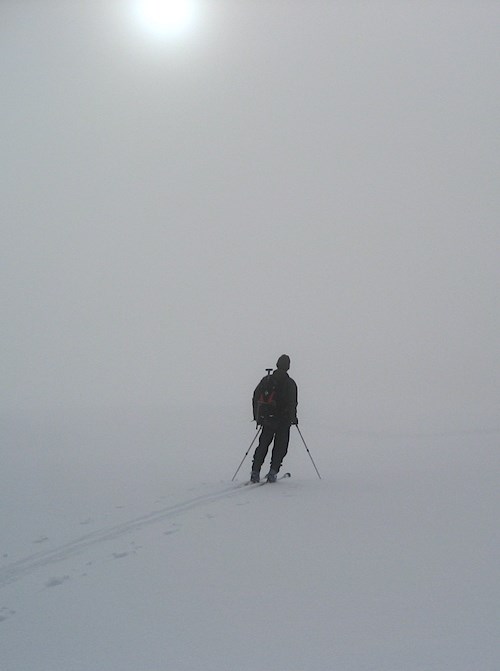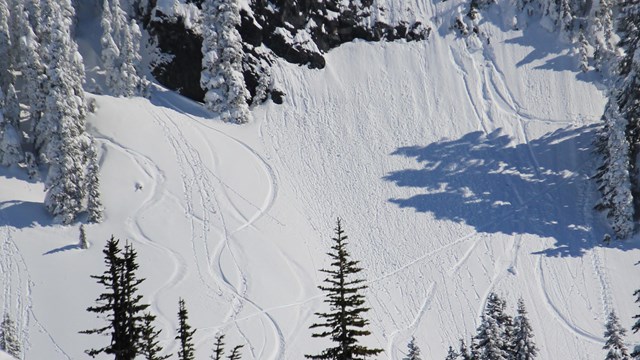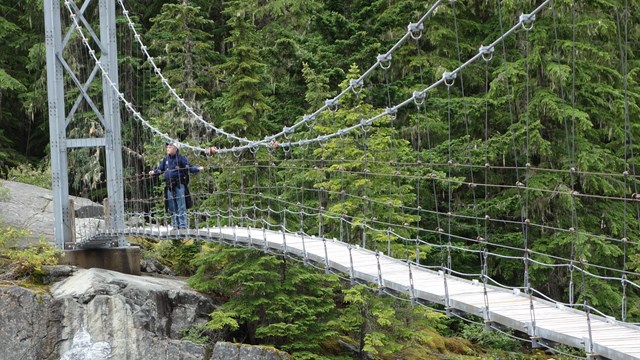|
Visit our keyboard shortcuts docs for details
It may be hot and summery at low elevations, but expect snow if you are coming to the park! Are you prepared to hike on snow in subalpine areas like Paradise? This video provides a short introduction to some of the hazards of hiking on snow in early summer, including snow-covered creeks. 
NPS Photo After a long, dark winter it can be exciting to be back in the park! However, it's also easy to underestimate the risks and hazards at higher elevations on the mountain. Rivers are running strong with melting snow, and snow can linger at the higher elevations well into June or July. You might think those months are "summer", but at Mount Rainier they still count as spring! Plan to be self-sufficient when traveling in the backcountry as the park does not mark hazards, stabilize avalanche slopes, or designate safe routes. You are responsible for your own safety. As you head out for a short snowshoe walk, up for a ski or ride, or a multi-day climb, plan for your own self-rescue. What will you do if you twist your ankle, or become stranded or lost? Does anyone know where you are going? It's up to YOU to get home safely. Tips for a safe spring hiking trip on Mount Rainier

NPS Graphic

NPS Photo
TranscriptHi, I’m Daniel, and I’m a Backcountry Ranger at Mount Rainier National Park. I thought I’d talk with you today about a couple of hazards we have in the backcountry here at Mount Rainier especially during the shoulder seasons. The first one I’ll talk about is in the spring. The biggest issue in the spring travelling in the backcountry is the possibility of punching through the snow and what happens is as you’re hiking along you may hear water but you don’t see the water. That’s a clue to sort a be on the alert. What’s usually happening is as we’re in the spring and the snow is melting and the water is rising in places it cuts a path under the snow and you don't see it. It’s easy to step through this and fall and be injured. The fall might be a foot but it might be six feet. And below that, it’s dark and it’s cold, and there may be swift water. It’s a dangerous situation. It can lead to hyperthermia, drowning, suffocation- bad news. So you want to be aware of what’s going on when you’re hiking in the shoulder season in the spring, which is usually May and June in particular. What happens is, you go in the water, things get dark, you flounder around- it’s scary. You don’t want that to happen. So what you need to do is perhaps if you have a trekking pole or a hiking stick as you’re hiking along, if you hear water but you don’t see it you might start poking out in front of you a bit with your hiking stick or trekking pole to just test the surface in front of you because the water and the cavity below may be in your path of travel. The other issue in the shoulder season, which would be in the fall, has to do with water as well, but more water coming from the sky. You get a lot of rains at Mount Rainier in the fall. That’s generally when we have the highest river levels are in the fall as we get a lot of rain and continue to get some snowmelt. If you’re hiking on a trail and you come to a creek or river that’s raging pretty high and in fact the bridge may be out, or the log crossing may be out, you need to make a smart decision about what you want to do at that time. If you think that you can ford the river, what you want to do is look up and down the riverbank for what appears to be the best crossing and then make a go. You want to- if you have a backpack on- you want to unbuckle the backpack because if you do fall over in the water you want to be able to get out of that pack as quickly as you can. It’s smart to be facing upstream as you’re making your crossing because you want to see what’s coming. That’s very critical. Now, on the other hand you may approach a crossing and find out that it may not be such a smart thing to try to make the crossing. If you hear loud noises like “BOOM BOOM BOOM” – something to that effect. What it is, is it’s really large boulders that are being pushed down the river by the force of the water. That’s an indication that just the force of the water could take you down and additionally it could mean that a boulder could take you down, so not a good idea. At that time you need to just sit on the riverbank, watch the river go by, enjoy the day, and then make your crossing when it’s safe. The best time to cross generally is in the morning when water levels are usually at their lowest. Later in the day as the temperatures rise, the water levels also rise. Have a safe time at Mount Rainier, and enjoy your visit.
Visit our keyboard shortcuts docs for details
Excited for spring? Fans of fall? We are too! But while warming temperatures melt away snow, they also expose new hazards hikers should be aware of. Make sure you have a safe and enjoyable transition between seasons and watch out for some of the hazards described by Backcountry Ranger Daniel in this video. 10 Essentials for Traveling on SnowBackcountry skiers, snowshoers, and campers should be equipped to survive nights out if whiteout conditions prevent travel. Carry the 10 Essentials for traveling on snow and know how to use them:
More information about the 10 Essentials. Be prepared for changing weather! 

Left image
Right image

Winter Safety
Winter can show you a different side of the park, but it also involves extra safety considerations such as the risk of avalanches. 
Hiking Safety
No matter the length of your hike, being aware of risks can help make your hiking experience safe and enjoyable! 
Spring Opening
Information on spring opening efforts, including road and utilities progress and more! |
Last updated: June 18, 2025
